Impact of Information Systems Strategy on HSBC's Business Performance
VerifiedAdded on 2023/01/11
|8
|2363
|97
Report
AI Summary
This report delves into the information strategy of HSBC, a multinational investment bank, and its impact on business performance. It begins by outlining the core concepts of IS strategy, emphasizing its role in achieving organizational objectives and gaining a competitive edge. The report then critically evaluates the influence of IS strategy on HSBC's performance, highlighting benefits such as improved efficiency, innovation, and enhanced customer service through modern digital technologies. It also acknowledges potential drawbacks, including technology security risks, high implementation costs, and job displacement due to automation. The analysis underscores the importance of a well-integrated IS strategy for businesses to thrive in the global market. The report concludes that while IS strategy significantly boosts business performance, it requires careful management to mitigate associated risks and maximize benefits.

SBM4202
Paraphrase This Document
Need a fresh take? Get an instant paraphrase of this document with our AI Paraphraser
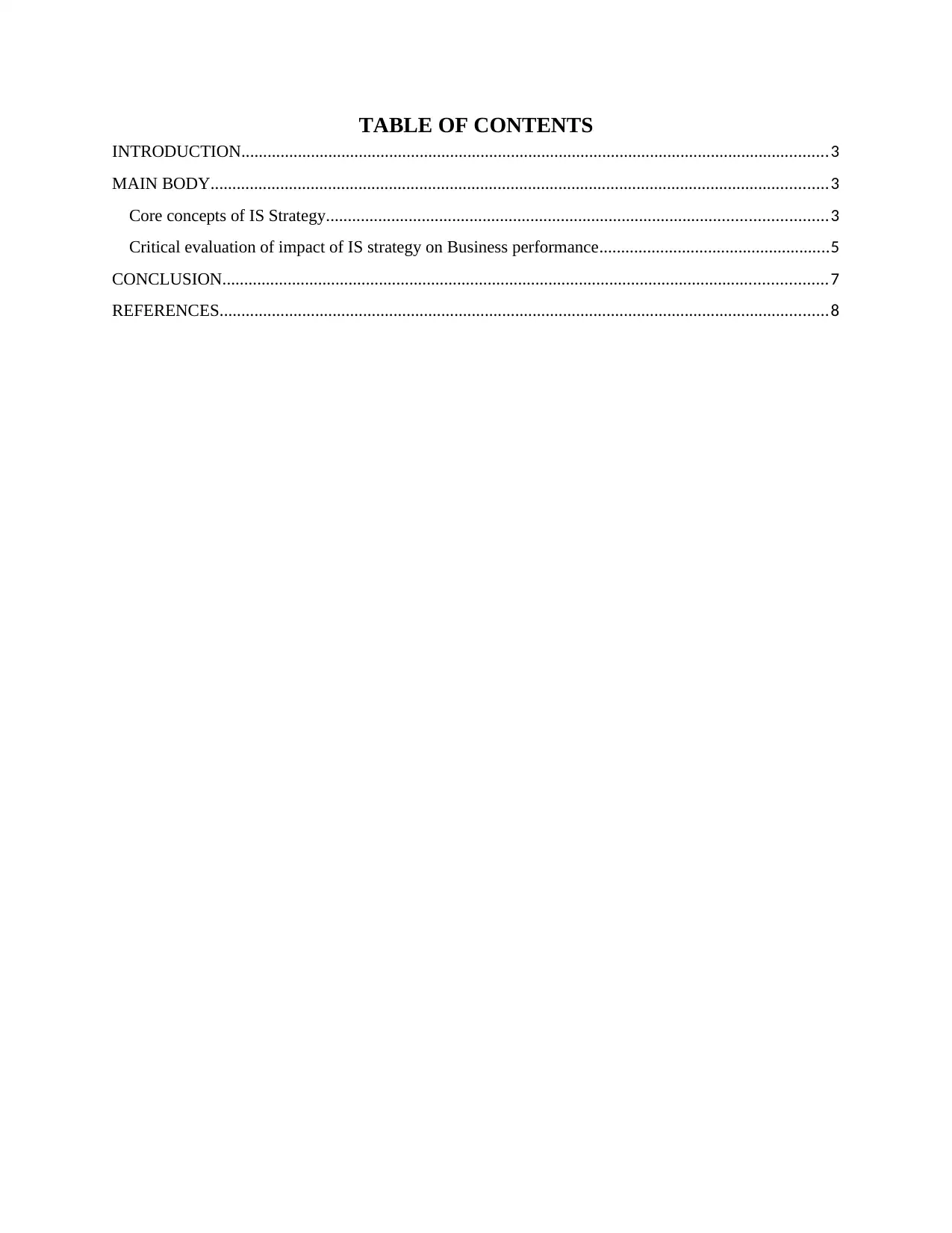
TABLE OF CONTENTS
INTRODUCTION.......................................................................................................................................3
MAIN BODY..............................................................................................................................................3
Core concepts of IS Strategy...................................................................................................................3
Critical evaluation of impact of IS strategy on Business performance.....................................................5
CONCLUSION...........................................................................................................................................7
REFERENCES............................................................................................................................................8
INTRODUCTION.......................................................................................................................................3
MAIN BODY..............................................................................................................................................3
Core concepts of IS Strategy...................................................................................................................3
Critical evaluation of impact of IS strategy on Business performance.....................................................5
CONCLUSION...........................................................................................................................................7
REFERENCES............................................................................................................................................8
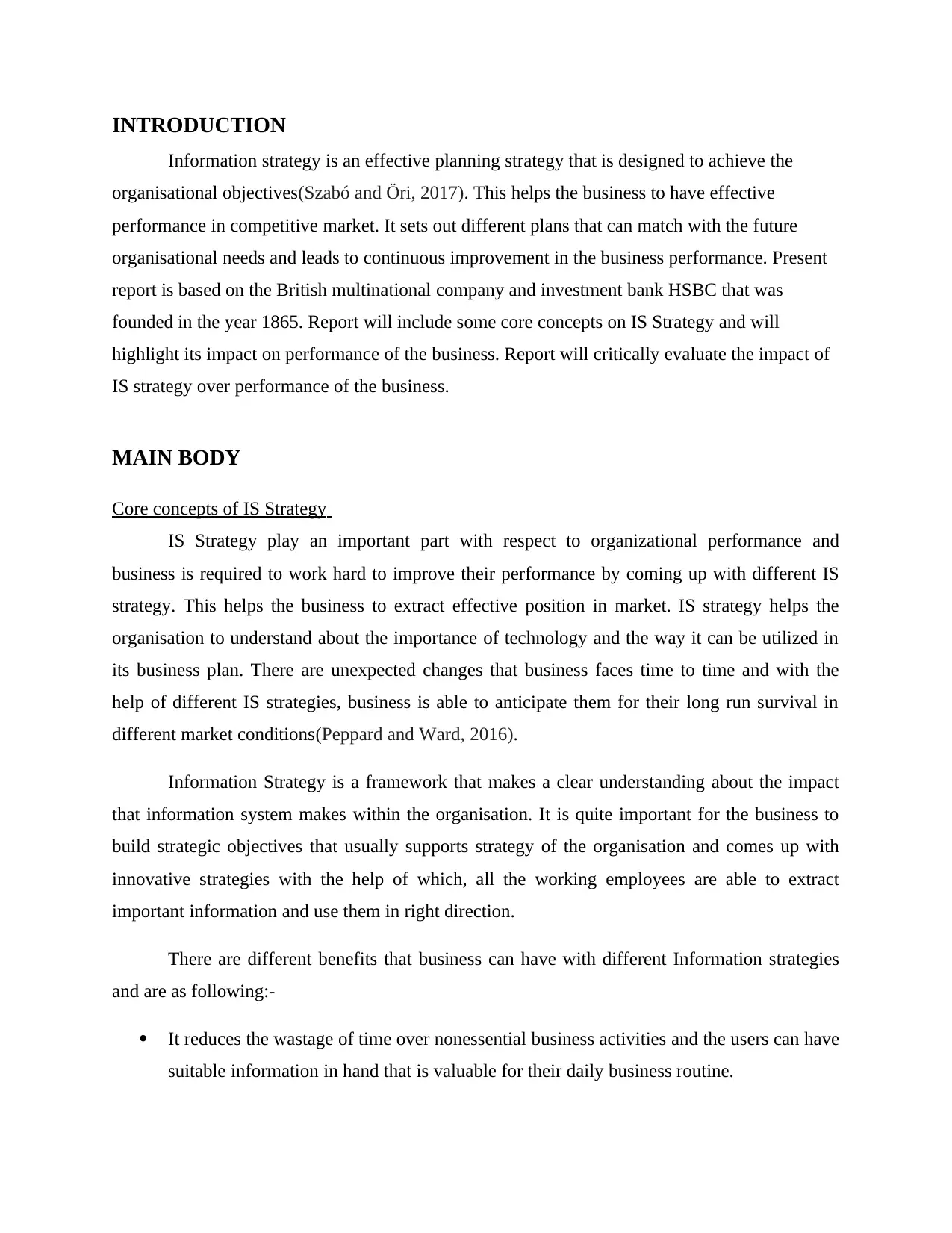
INTRODUCTION
Information strategy is an effective planning strategy that is designed to achieve the
organisational objectives(Szabó and Öri, 2017). This helps the business to have effective
performance in competitive market. It sets out different plans that can match with the future
organisational needs and leads to continuous improvement in the business performance. Present
report is based on the British multinational company and investment bank HSBC that was
founded in the year 1865. Report will include some core concepts on IS Strategy and will
highlight its impact on performance of the business. Report will critically evaluate the impact of
IS strategy over performance of the business.
MAIN BODY
Core concepts of IS Strategy
IS Strategy play an important part with respect to organizational performance and
business is required to work hard to improve their performance by coming up with different IS
strategy. This helps the business to extract effective position in market. IS strategy helps the
organisation to understand about the importance of technology and the way it can be utilized in
its business plan. There are unexpected changes that business faces time to time and with the
help of different IS strategies, business is able to anticipate them for their long run survival in
different market conditions(Peppard and Ward, 2016).
Information Strategy is a framework that makes a clear understanding about the impact
that information system makes within the organisation. It is quite important for the business to
build strategic objectives that usually supports strategy of the organisation and comes up with
innovative strategies with the help of which, all the working employees are able to extract
important information and use them in right direction.
There are different benefits that business can have with different Information strategies
and are as following:-
It reduces the wastage of time over nonessential business activities and the users can have
suitable information in hand that is valuable for their daily business routine.
Information strategy is an effective planning strategy that is designed to achieve the
organisational objectives(Szabó and Öri, 2017). This helps the business to have effective
performance in competitive market. It sets out different plans that can match with the future
organisational needs and leads to continuous improvement in the business performance. Present
report is based on the British multinational company and investment bank HSBC that was
founded in the year 1865. Report will include some core concepts on IS Strategy and will
highlight its impact on performance of the business. Report will critically evaluate the impact of
IS strategy over performance of the business.
MAIN BODY
Core concepts of IS Strategy
IS Strategy play an important part with respect to organizational performance and
business is required to work hard to improve their performance by coming up with different IS
strategy. This helps the business to extract effective position in market. IS strategy helps the
organisation to understand about the importance of technology and the way it can be utilized in
its business plan. There are unexpected changes that business faces time to time and with the
help of different IS strategies, business is able to anticipate them for their long run survival in
different market conditions(Peppard and Ward, 2016).
Information Strategy is a framework that makes a clear understanding about the impact
that information system makes within the organisation. It is quite important for the business to
build strategic objectives that usually supports strategy of the organisation and comes up with
innovative strategies with the help of which, all the working employees are able to extract
important information and use them in right direction.
There are different benefits that business can have with different Information strategies
and are as following:-
It reduces the wastage of time over nonessential business activities and the users can have
suitable information in hand that is valuable for their daily business routine.
⊘ This is a preview!⊘
Do you want full access?
Subscribe today to unlock all pages.

Trusted by 1+ million students worldwide
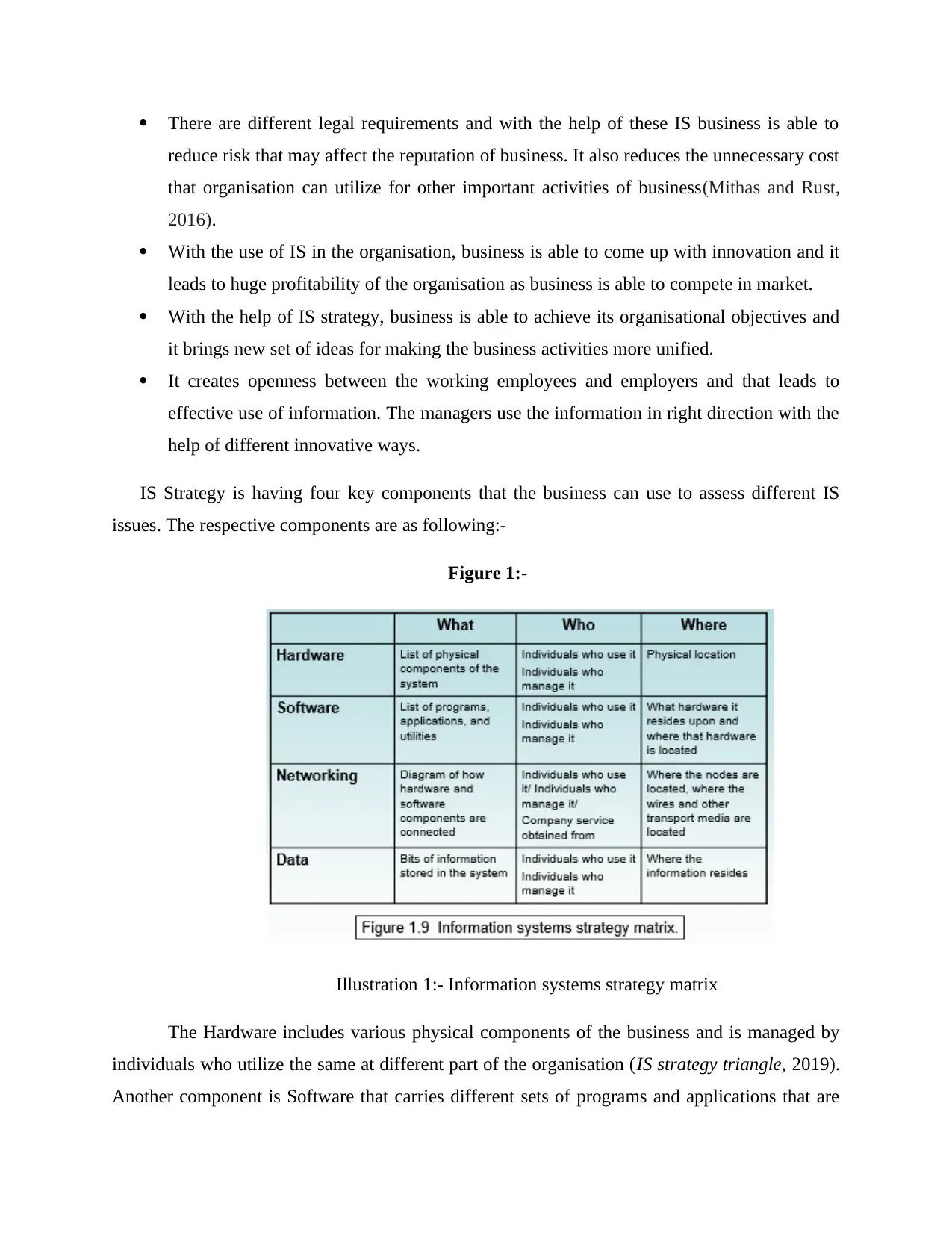
There are different legal requirements and with the help of these IS business is able to
reduce risk that may affect the reputation of business. It also reduces the unnecessary cost
that organisation can utilize for other important activities of business(Mithas and Rust,
2016).
With the use of IS in the organisation, business is able to come up with innovation and it
leads to huge profitability of the organisation as business is able to compete in market.
With the help of IS strategy, business is able to achieve its organisational objectives and
it brings new set of ideas for making the business activities more unified.
It creates openness between the working employees and employers and that leads to
effective use of information. The managers use the information in right direction with the
help of different innovative ways.
IS Strategy is having four key components that the business can use to assess different IS
issues. The respective components are as following:-
Figure 1:-
Illustration 1:- Information systems strategy matrix
The Hardware includes various physical components of the business and is managed by
individuals who utilize the same at different part of the organisation (IS strategy triangle, 2019).
Another component is Software that carries different sets of programs and applications that are
reduce risk that may affect the reputation of business. It also reduces the unnecessary cost
that organisation can utilize for other important activities of business(Mithas and Rust,
2016).
With the use of IS in the organisation, business is able to come up with innovation and it
leads to huge profitability of the organisation as business is able to compete in market.
With the help of IS strategy, business is able to achieve its organisational objectives and
it brings new set of ideas for making the business activities more unified.
It creates openness between the working employees and employers and that leads to
effective use of information. The managers use the information in right direction with the
help of different innovative ways.
IS Strategy is having four key components that the business can use to assess different IS
issues. The respective components are as following:-
Figure 1:-
Illustration 1:- Information systems strategy matrix
The Hardware includes various physical components of the business and is managed by
individuals who utilize the same at different part of the organisation (IS strategy triangle, 2019).
Another component is Software that carries different sets of programs and applications that are
Paraphrase This Document
Need a fresh take? Get an instant paraphrase of this document with our AI Paraphraser
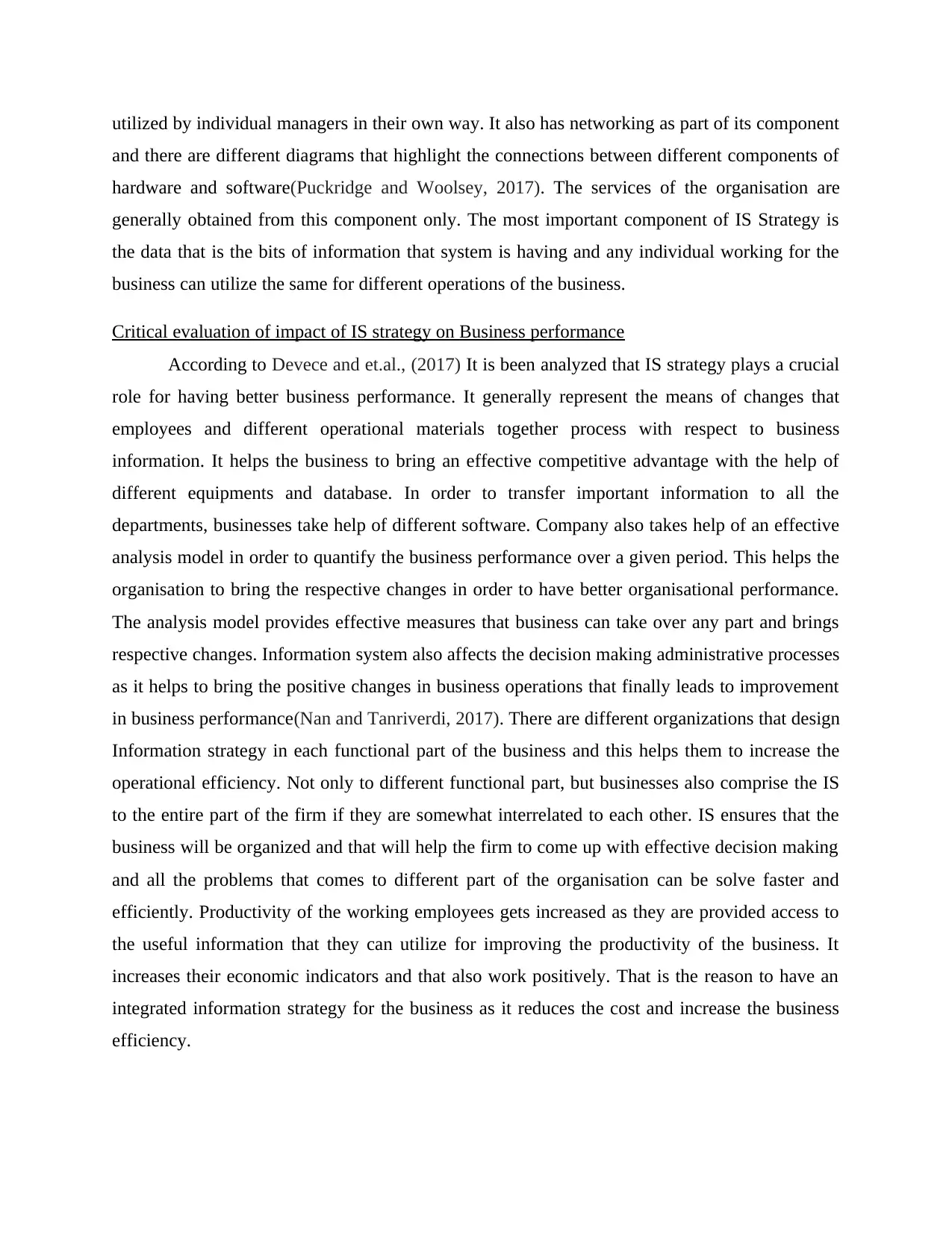
utilized by individual managers in their own way. It also has networking as part of its component
and there are different diagrams that highlight the connections between different components of
hardware and software(Puckridge and Woolsey, 2017). The services of the organisation are
generally obtained from this component only. The most important component of IS Strategy is
the data that is the bits of information that system is having and any individual working for the
business can utilize the same for different operations of the business.
Critical evaluation of impact of IS strategy on Business performance
According to Devece and et.al., (2017) It is been analyzed that IS strategy plays a crucial
role for having better business performance. It generally represent the means of changes that
employees and different operational materials together process with respect to business
information. It helps the business to bring an effective competitive advantage with the help of
different equipments and database. In order to transfer important information to all the
departments, businesses take help of different software. Company also takes help of an effective
analysis model in order to quantify the business performance over a given period. This helps the
organisation to bring the respective changes in order to have better organisational performance.
The analysis model provides effective measures that business can take over any part and brings
respective changes. Information system also affects the decision making administrative processes
as it helps to bring the positive changes in business operations that finally leads to improvement
in business performance(Nan and Tanriverdi, 2017). There are different organizations that design
Information strategy in each functional part of the business and this helps them to increase the
operational efficiency. Not only to different functional part, but businesses also comprise the IS
to the entire part of the firm if they are somewhat interrelated to each other. IS ensures that the
business will be organized and that will help the firm to come up with effective decision making
and all the problems that comes to different part of the organisation can be solve faster and
efficiently. Productivity of the working employees gets increased as they are provided access to
the useful information that they can utilize for improving the productivity of the business. It
increases their economic indicators and that also work positively. That is the reason to have an
integrated information strategy for the business as it reduces the cost and increase the business
efficiency.
and there are different diagrams that highlight the connections between different components of
hardware and software(Puckridge and Woolsey, 2017). The services of the organisation are
generally obtained from this component only. The most important component of IS Strategy is
the data that is the bits of information that system is having and any individual working for the
business can utilize the same for different operations of the business.
Critical evaluation of impact of IS strategy on Business performance
According to Devece and et.al., (2017) It is been analyzed that IS strategy plays a crucial
role for having better business performance. It generally represent the means of changes that
employees and different operational materials together process with respect to business
information. It helps the business to bring an effective competitive advantage with the help of
different equipments and database. In order to transfer important information to all the
departments, businesses take help of different software. Company also takes help of an effective
analysis model in order to quantify the business performance over a given period. This helps the
organisation to bring the respective changes in order to have better organisational performance.
The analysis model provides effective measures that business can take over any part and brings
respective changes. Information system also affects the decision making administrative processes
as it helps to bring the positive changes in business operations that finally leads to improvement
in business performance(Nan and Tanriverdi, 2017). There are different organizations that design
Information strategy in each functional part of the business and this helps them to increase the
operational efficiency. Not only to different functional part, but businesses also comprise the IS
to the entire part of the firm if they are somewhat interrelated to each other. IS ensures that the
business will be organized and that will help the firm to come up with effective decision making
and all the problems that comes to different part of the organisation can be solve faster and
efficiently. Productivity of the working employees gets increased as they are provided access to
the useful information that they can utilize for improving the productivity of the business. It
increases their economic indicators and that also work positively. That is the reason to have an
integrated information strategy for the business as it reduces the cost and increase the business
efficiency.
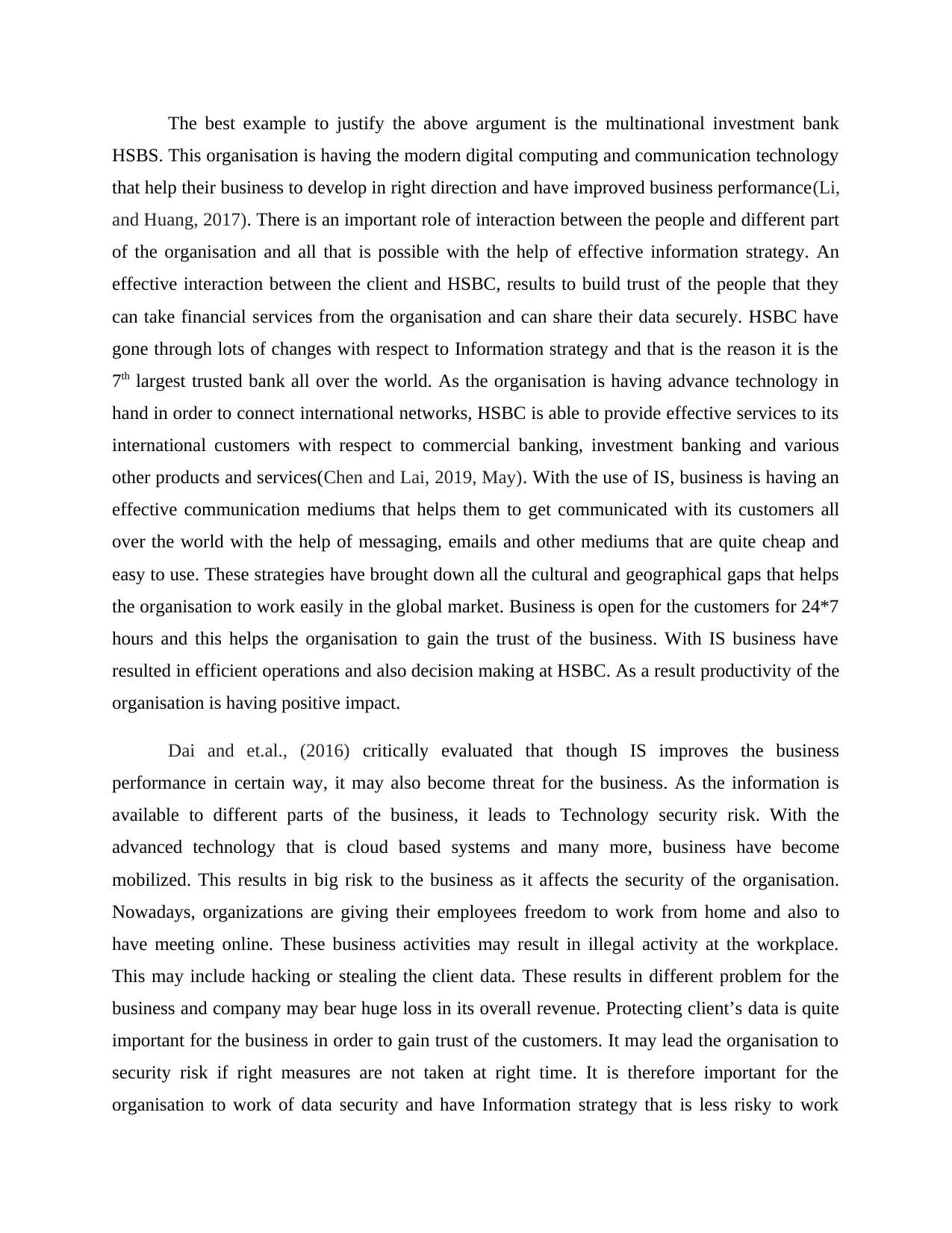
The best example to justify the above argument is the multinational investment bank
HSBS. This organisation is having the modern digital computing and communication technology
that help their business to develop in right direction and have improved business performance(Li,
and Huang, 2017). There is an important role of interaction between the people and different part
of the organisation and all that is possible with the help of effective information strategy. An
effective interaction between the client and HSBC, results to build trust of the people that they
can take financial services from the organisation and can share their data securely. HSBC have
gone through lots of changes with respect to Information strategy and that is the reason it is the
7th largest trusted bank all over the world. As the organisation is having advance technology in
hand in order to connect international networks, HSBC is able to provide effective services to its
international customers with respect to commercial banking, investment banking and various
other products and services(Chen and Lai, 2019, May). With the use of IS, business is having an
effective communication mediums that helps them to get communicated with its customers all
over the world with the help of messaging, emails and other mediums that are quite cheap and
easy to use. These strategies have brought down all the cultural and geographical gaps that helps
the organisation to work easily in the global market. Business is open for the customers for 24*7
hours and this helps the organisation to gain the trust of the business. With IS business have
resulted in efficient operations and also decision making at HSBC. As a result productivity of the
organisation is having positive impact.
Dai and et.al., (2016) critically evaluated that though IS improves the business
performance in certain way, it may also become threat for the business. As the information is
available to different parts of the business, it leads to Technology security risk. With the
advanced technology that is cloud based systems and many more, business have become
mobilized. This results in big risk to the business as it affects the security of the organisation.
Nowadays, organizations are giving their employees freedom to work from home and also to
have meeting online. These business activities may result in illegal activity at the workplace.
This may include hacking or stealing the client data. These results in different problem for the
business and company may bear huge loss in its overall revenue. Protecting client’s data is quite
important for the business in order to gain trust of the customers. It may lead the organisation to
security risk if right measures are not taken at right time. It is therefore important for the
organisation to work of data security and have Information strategy that is less risky to work
HSBS. This organisation is having the modern digital computing and communication technology
that help their business to develop in right direction and have improved business performance(Li,
and Huang, 2017). There is an important role of interaction between the people and different part
of the organisation and all that is possible with the help of effective information strategy. An
effective interaction between the client and HSBC, results to build trust of the people that they
can take financial services from the organisation and can share their data securely. HSBC have
gone through lots of changes with respect to Information strategy and that is the reason it is the
7th largest trusted bank all over the world. As the organisation is having advance technology in
hand in order to connect international networks, HSBC is able to provide effective services to its
international customers with respect to commercial banking, investment banking and various
other products and services(Chen and Lai, 2019, May). With the use of IS, business is having an
effective communication mediums that helps them to get communicated with its customers all
over the world with the help of messaging, emails and other mediums that are quite cheap and
easy to use. These strategies have brought down all the cultural and geographical gaps that helps
the organisation to work easily in the global market. Business is open for the customers for 24*7
hours and this helps the organisation to gain the trust of the business. With IS business have
resulted in efficient operations and also decision making at HSBC. As a result productivity of the
organisation is having positive impact.
Dai and et.al., (2016) critically evaluated that though IS improves the business
performance in certain way, it may also become threat for the business. As the information is
available to different parts of the business, it leads to Technology security risk. With the
advanced technology that is cloud based systems and many more, business have become
mobilized. This results in big risk to the business as it affects the security of the organisation.
Nowadays, organizations are giving their employees freedom to work from home and also to
have meeting online. These business activities may result in illegal activity at the workplace.
This may include hacking or stealing the client data. These results in different problem for the
business and company may bear huge loss in its overall revenue. Protecting client’s data is quite
important for the business in order to gain trust of the customers. It may lead the organisation to
security risk if right measures are not taken at right time. It is therefore important for the
organisation to work of data security and have Information strategy that is less risky to work
⊘ This is a preview!⊘
Do you want full access?
Subscribe today to unlock all pages.

Trusted by 1+ million students worldwide
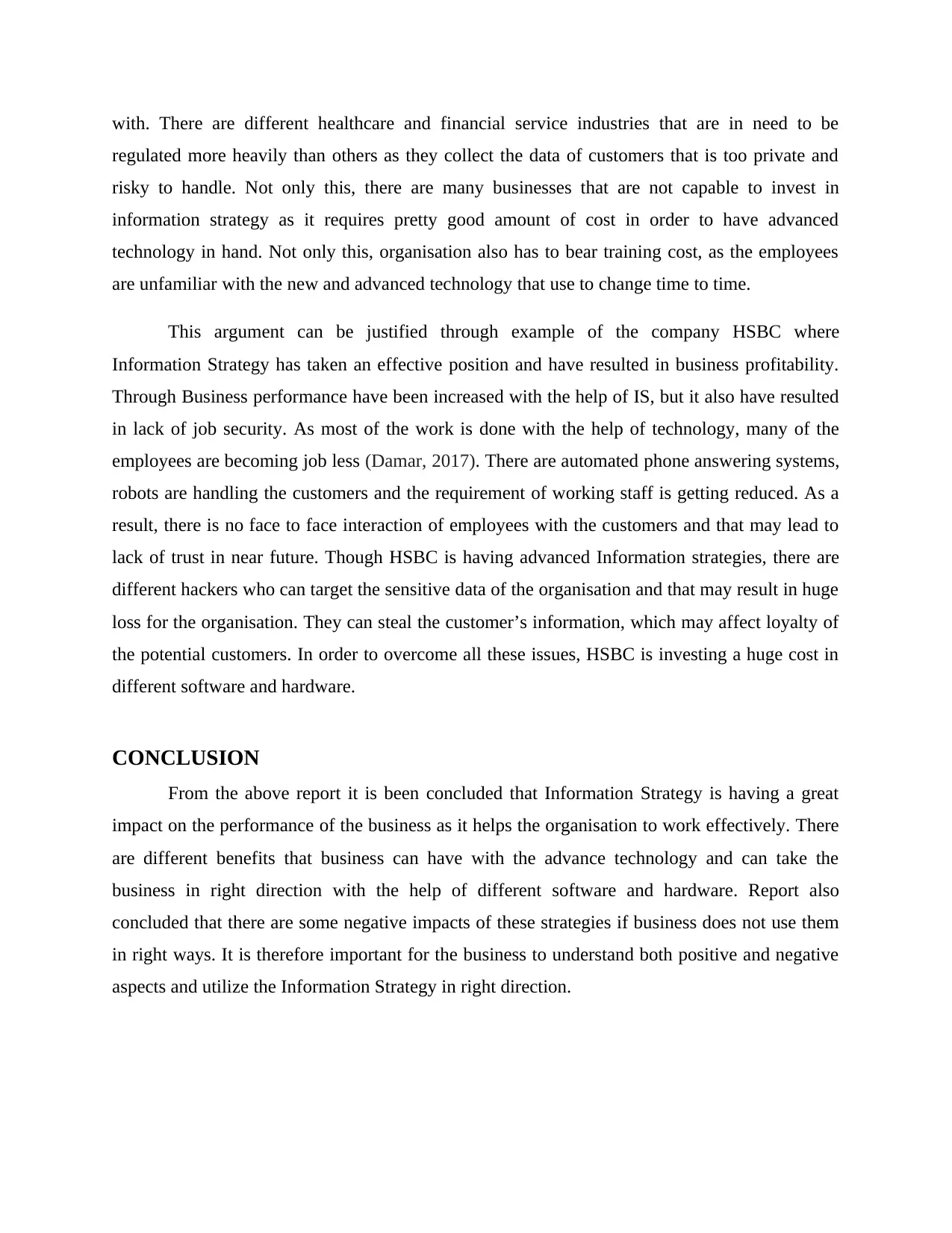
with. There are different healthcare and financial service industries that are in need to be
regulated more heavily than others as they collect the data of customers that is too private and
risky to handle. Not only this, there are many businesses that are not capable to invest in
information strategy as it requires pretty good amount of cost in order to have advanced
technology in hand. Not only this, organisation also has to bear training cost, as the employees
are unfamiliar with the new and advanced technology that use to change time to time.
This argument can be justified through example of the company HSBC where
Information Strategy has taken an effective position and have resulted in business profitability.
Through Business performance have been increased with the help of IS, but it also have resulted
in lack of job security. As most of the work is done with the help of technology, many of the
employees are becoming job less (Damar, 2017). There are automated phone answering systems,
robots are handling the customers and the requirement of working staff is getting reduced. As a
result, there is no face to face interaction of employees with the customers and that may lead to
lack of trust in near future. Though HSBC is having advanced Information strategies, there are
different hackers who can target the sensitive data of the organisation and that may result in huge
loss for the organisation. They can steal the customer’s information, which may affect loyalty of
the potential customers. In order to overcome all these issues, HSBC is investing a huge cost in
different software and hardware.
CONCLUSION
From the above report it is been concluded that Information Strategy is having a great
impact on the performance of the business as it helps the organisation to work effectively. There
are different benefits that business can have with the advance technology and can take the
business in right direction with the help of different software and hardware. Report also
concluded that there are some negative impacts of these strategies if business does not use them
in right ways. It is therefore important for the business to understand both positive and negative
aspects and utilize the Information Strategy in right direction.
regulated more heavily than others as they collect the data of customers that is too private and
risky to handle. Not only this, there are many businesses that are not capable to invest in
information strategy as it requires pretty good amount of cost in order to have advanced
technology in hand. Not only this, organisation also has to bear training cost, as the employees
are unfamiliar with the new and advanced technology that use to change time to time.
This argument can be justified through example of the company HSBC where
Information Strategy has taken an effective position and have resulted in business profitability.
Through Business performance have been increased with the help of IS, but it also have resulted
in lack of job security. As most of the work is done with the help of technology, many of the
employees are becoming job less (Damar, 2017). There are automated phone answering systems,
robots are handling the customers and the requirement of working staff is getting reduced. As a
result, there is no face to face interaction of employees with the customers and that may lead to
lack of trust in near future. Though HSBC is having advanced Information strategies, there are
different hackers who can target the sensitive data of the organisation and that may result in huge
loss for the organisation. They can steal the customer’s information, which may affect loyalty of
the potential customers. In order to overcome all these issues, HSBC is investing a huge cost in
different software and hardware.
CONCLUSION
From the above report it is been concluded that Information Strategy is having a great
impact on the performance of the business as it helps the organisation to work effectively. There
are different benefits that business can have with the advance technology and can take the
business in right direction with the help of different software and hardware. Report also
concluded that there are some negative impacts of these strategies if business does not use them
in right ways. It is therefore important for the business to understand both positive and negative
aspects and utilize the Information Strategy in right direction.
Paraphrase This Document
Need a fresh take? Get an instant paraphrase of this document with our AI Paraphraser
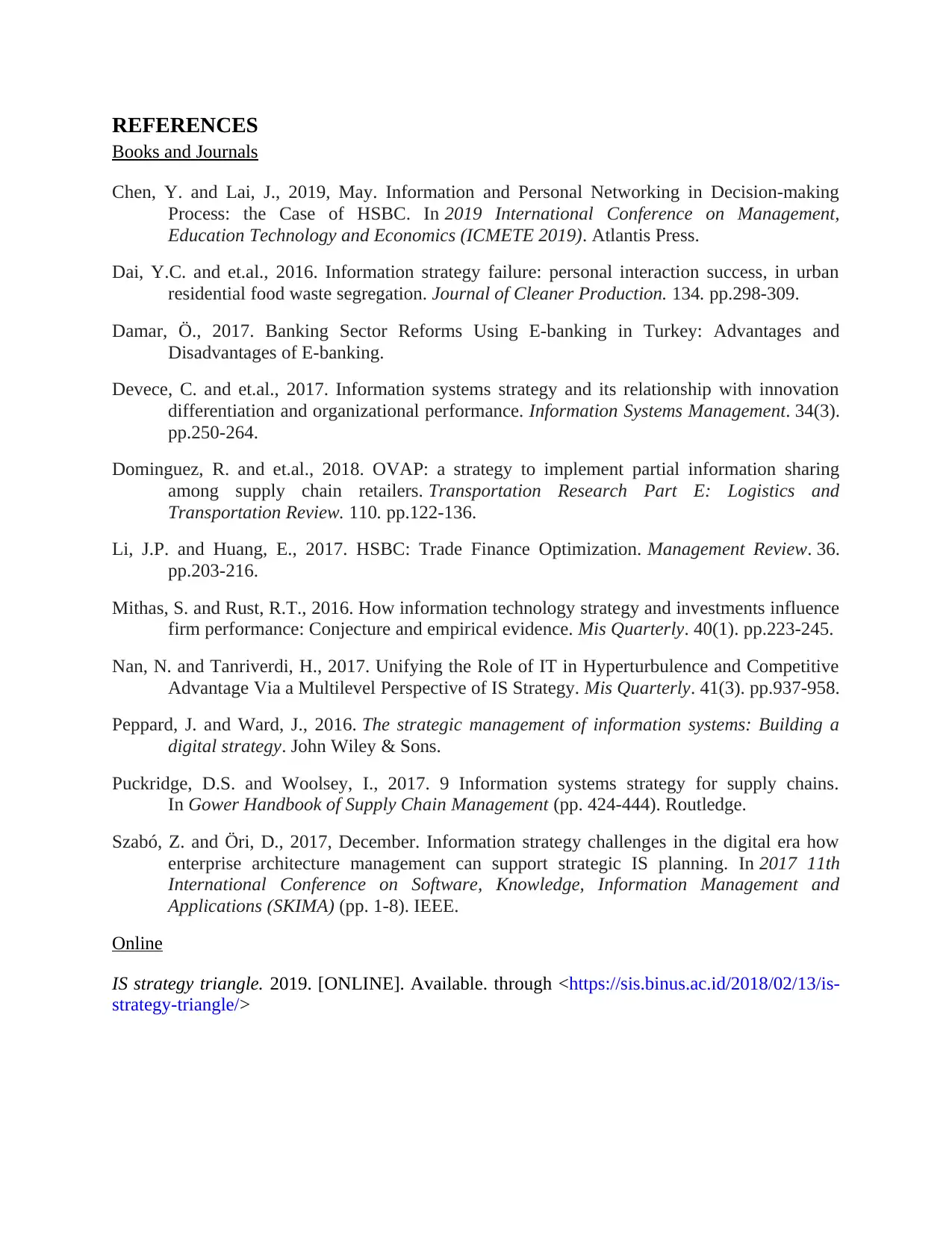
REFERENCES
Books and Journals
Chen, Y. and Lai, J., 2019, May. Information and Personal Networking in Decision-making
Process: the Case of HSBC. In 2019 International Conference on Management,
Education Technology and Economics (ICMETE 2019). Atlantis Press.
Dai, Y.C. and et.al., 2016. Information strategy failure: personal interaction success, in urban
residential food waste segregation. Journal of Cleaner Production. 134. pp.298-309.
Damar, Ö., 2017. Banking Sector Reforms Using E-banking in Turkey: Advantages and
Disadvantages of E-banking.
Devece, C. and et.al., 2017. Information systems strategy and its relationship with innovation
differentiation and organizational performance. Information Systems Management. 34(3).
pp.250-264.
Dominguez, R. and et.al., 2018. OVAP: a strategy to implement partial information sharing
among supply chain retailers. Transportation Research Part E: Logistics and
Transportation Review. 110. pp.122-136.
Li, J.P. and Huang, E., 2017. HSBC: Trade Finance Optimization. Management Review. 36.
pp.203-216.
Mithas, S. and Rust, R.T., 2016. How information technology strategy and investments influence
firm performance: Conjecture and empirical evidence. Mis Quarterly. 40(1). pp.223-245.
Nan, N. and Tanriverdi, H., 2017. Unifying the Role of IT in Hyperturbulence and Competitive
Advantage Via a Multilevel Perspective of IS Strategy. Mis Quarterly. 41(3). pp.937-958.
Peppard, J. and Ward, J., 2016. The strategic management of information systems: Building a
digital strategy. John Wiley & Sons.
Puckridge, D.S. and Woolsey, I., 2017. 9 Information systems strategy for supply chains.
In Gower Handbook of Supply Chain Management (pp. 424-444). Routledge.
Szabó, Z. and Öri, D., 2017, December. Information strategy challenges in the digital era how
enterprise architecture management can support strategic IS planning. In 2017 11th
International Conference on Software, Knowledge, Information Management and
Applications (SKIMA) (pp. 1-8). IEEE.
Online
IS strategy triangle. 2019. [ONLINE]. Available. through <https://sis.binus.ac.id/2018/02/13/is-
strategy-triangle/>
Books and Journals
Chen, Y. and Lai, J., 2019, May. Information and Personal Networking in Decision-making
Process: the Case of HSBC. In 2019 International Conference on Management,
Education Technology and Economics (ICMETE 2019). Atlantis Press.
Dai, Y.C. and et.al., 2016. Information strategy failure: personal interaction success, in urban
residential food waste segregation. Journal of Cleaner Production. 134. pp.298-309.
Damar, Ö., 2017. Banking Sector Reforms Using E-banking in Turkey: Advantages and
Disadvantages of E-banking.
Devece, C. and et.al., 2017. Information systems strategy and its relationship with innovation
differentiation and organizational performance. Information Systems Management. 34(3).
pp.250-264.
Dominguez, R. and et.al., 2018. OVAP: a strategy to implement partial information sharing
among supply chain retailers. Transportation Research Part E: Logistics and
Transportation Review. 110. pp.122-136.
Li, J.P. and Huang, E., 2017. HSBC: Trade Finance Optimization. Management Review. 36.
pp.203-216.
Mithas, S. and Rust, R.T., 2016. How information technology strategy and investments influence
firm performance: Conjecture and empirical evidence. Mis Quarterly. 40(1). pp.223-245.
Nan, N. and Tanriverdi, H., 2017. Unifying the Role of IT in Hyperturbulence and Competitive
Advantage Via a Multilevel Perspective of IS Strategy. Mis Quarterly. 41(3). pp.937-958.
Peppard, J. and Ward, J., 2016. The strategic management of information systems: Building a
digital strategy. John Wiley & Sons.
Puckridge, D.S. and Woolsey, I., 2017. 9 Information systems strategy for supply chains.
In Gower Handbook of Supply Chain Management (pp. 424-444). Routledge.
Szabó, Z. and Öri, D., 2017, December. Information strategy challenges in the digital era how
enterprise architecture management can support strategic IS planning. In 2017 11th
International Conference on Software, Knowledge, Information Management and
Applications (SKIMA) (pp. 1-8). IEEE.
Online
IS strategy triangle. 2019. [ONLINE]. Available. through <https://sis.binus.ac.id/2018/02/13/is-
strategy-triangle/>
1 out of 8
Related Documents
Your All-in-One AI-Powered Toolkit for Academic Success.
+13062052269
info@desklib.com
Available 24*7 on WhatsApp / Email
![[object Object]](/_next/static/media/star-bottom.7253800d.svg)
Unlock your academic potential
Copyright © 2020–2025 A2Z Services. All Rights Reserved. Developed and managed by ZUCOL.





